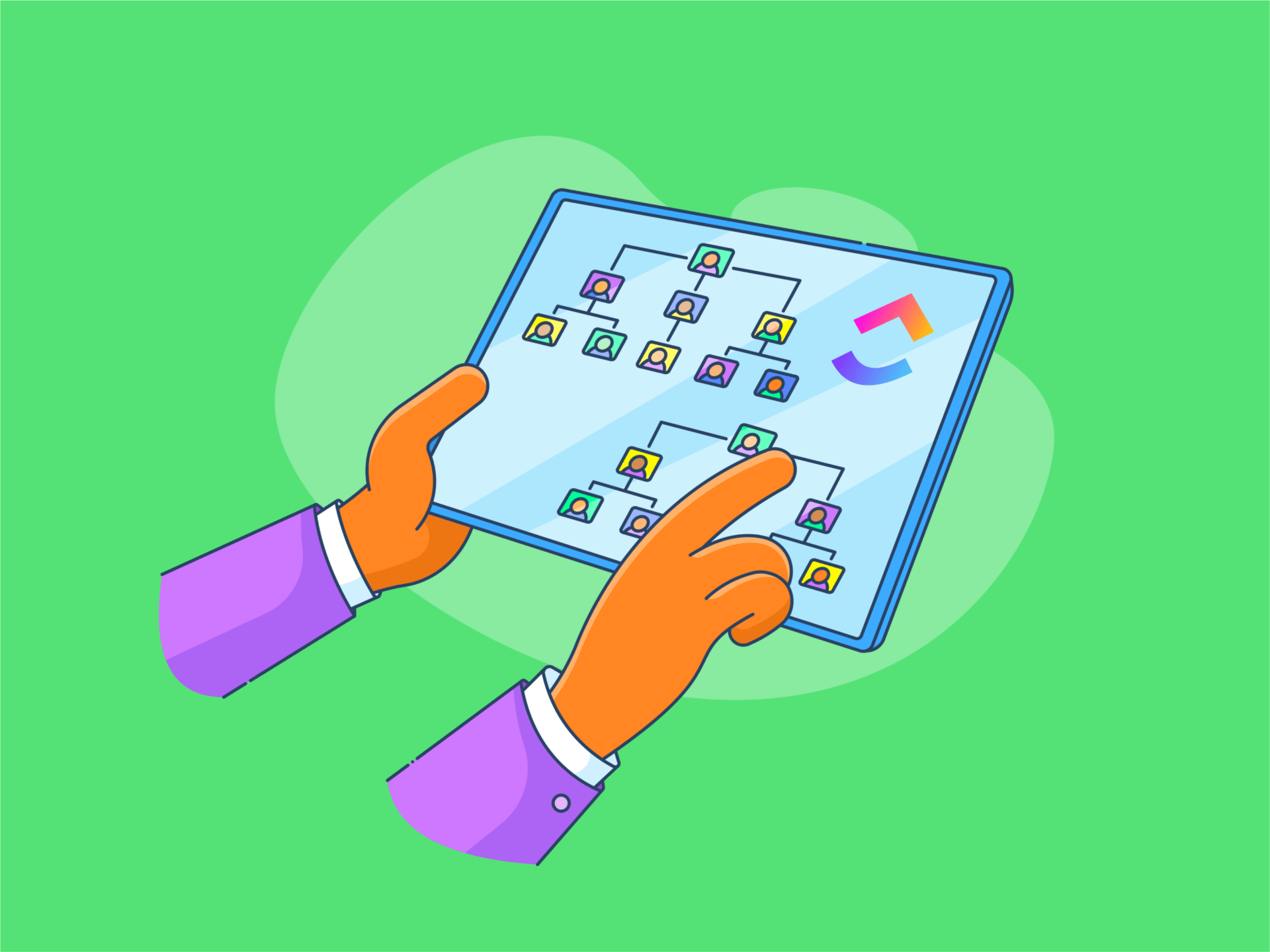

Today, when more than a quarter of global employees want to leave their current jobs, retaining employees is more critical than ever. Employers who are not prioritizing retaining talent will find themselves struggling.
Successful talent retention is no longer just about paychecks. It requires organizations to provide employees with a great company culture, meet their emotional needs, and offer support toward their career goals.
Use this advanced human resource management guide to understand how to retain top-talent employees today.
Summary
- Employee retention depends on your recruitment and talent management methods
- Comprehensive onboarding and training can help improve employee retention rates
- There are eight strategies for retaining top talent employees:
- Motivate, recognize, and reward them
- Offer career development opportunities
- Stress upon flexible work arrangements
- Build an inclusive, supportive, and respectful culture at work
- Improve with feedback
- Show empathy
- Combat the reasons for turnover
- Utilize technology and AI to improve and accelerate processes
- Summary
- What is Employee Retention?
- The Impact of Effective Recruitment in Retaining Top Talent
- How Onboarding and Training Improve Employee Retention
- How to Retain Top-Talent Employees: 8 Strategies
- 1. Motivate—and incentivize—employees
- 2. Drive career development opportunities
- 3. Adopt flexible work options and focus on stress management
- 4. Build a positive organizational culture
- 5. Drive decisions based on talent feedback
- 6. Showcase empathy
- 7. Don’t turn a blind eye to your turnover rate
- 8. Use automation when onboarding employees
- Keep High-Quality Talent At the Center of Your Retention Strategy, Always
- Frequently Asked Questions (FAQ)
What is Employee Retention?
Simply put, employee retention is your organization’s ability to hold onto its employees. It requires using retention strategies to keep talented and productive employees within the organization. The focus is on building a positive work culture to reduce employee turnover. However, employee retention cannot be viewed in isolation. How you retain talent depends on:
- Your recruitment strategy
- The way you drive talent management and employee satisfaction
Let’s understand how improving one area has a trickle-down effect on others.
1. Start with your recruitment strategy
Managing talent starts way before an employee joins the company; it begins with your recruitment strategy:
- Do potential candidates find the application process quick, easy, and seamless?
- Do candidates view your screening process as fair, respectful, and objective?
- Are you interviewing candidates holistically, including hard and soft skills?
- Does your screening process put the candidate’s interests at the forefront?
You can only attract quality talent by gaining the candidate’s trust from day one and using your recruitment strategy to show them you care.
Pro tip: Use ClickUp Brain’s AI tools to write job descriptions, generate suitable interview questions, summarize notes from interviews, and create a bank of emails for all stages of the recruitment cycle
2. Drive goodwill with your talent management efforts
Once the employee has entered your organization, it’s time to focus on your talent management initiatives—one of the most basic requirements for employee retention.
Organizations where employees are very satisfied with their managers report:
- 72% reduction in attrition
- 3.2x increase in employee motivation
- 13.9x increase in job satisfaction
Working on your talent management strategy gets a big thumbs up from employees. But what do we mean by talent management?
Talent management is the strategic process of recruiting, developing, retaining, and optimizing talent within an organization to meet its current and future business objectives. It includes key activities such as recruitment, training and development, onboarding, succession planning, performance management, and so on.
The Impact of Effective Recruitment in Retaining Top Talent
Let’s see how talent management is tied to recruiting employees the right way. The employment landscape is not easy for employers, considering that the average cost per hire runs into thousands of dollars. A poor experience with the organization at any step can push top-performing talent out the door, leaving all the effort into hiring them to waste.
To prevent this costly misstep, it’s essential to reimagine your recruitment strategy, hone your employees’ skills, and identify candidates who’ll stay the course.
Here are some tips:
- Job description: Evaluate the skills needed for the job and rewrite the job description to set the right expectation
- Culture fit: Evaluate the organization’s cultural aspects and assess your candidate’s fit to see if they share the same core values, beliefs, and objectives
- Well-rounded skills: Go for candidates with at least 70 to 80% of the critical skills required for a specific role. Also, look for interests outside of work, such as volunteering, playing a team sport, etc.
- Test: Promote micro internships where candidates can assess their fit within the organization
- Talent pool: Expand your search and tap into hidden employee bases, including retired people and recent mothers looking to rejoin the workforce.
- Interest: Assess how invested the candidate is in joining your company. Interested candidates typically research the brand, ask questions, and show enthusiasm.
How Onboarding and Training Improve Employee Retention
Most employers experience an improvement in retention with a robust and structured onboarding process.
Proper onboarding boosts retention, improves employee productivity, and drives engagement. Employees who feel a greater sense of belonging with the team become vital assets to the company.
Here’s why onboarding and training are instrumental to your employee retention efforts:
Makes employees happier and well-informed
Almost a third of new hires will exit a company within the first 90 days due to a poor onboarding experience.
This can be counteracted with onboarding training, which includes introducing new hires to the company’s values, culture, policies, facilities, and people.
Helps employees understand the organizational expectations
An onboarding and training program encourages employees to participate in key activities and better understand their job roles, responsibilities, and employer’s expectations. They can access relevant training material such as guides, how-to articles, company videos, FAQs, etc., and succeed in their new role.
Improves employee morale and job satisfaction
Employees’ productivity and morale skyrocket as they continue to get trained on emerging trends, skill sets, and company processes. Training employees as they are onboarding allows them to enhance their performance and meet or exceed the organization’s goals early in the employee lifecycle.
Enables employees to be well-integrated into the team
Employees who fit into the job role and blend with the team from day one can work with greater confidence and clarity. Plus, onboarding empowers employees with the space to ask questions, learn how to perform in their jobs, and clear misunderstandings along the way. On the other hand, the organization leverages training material to communicate its expectations from the employee and hit the ground running.
Drives an interactive learning experience for employees
Supplementing your onboarding with on-the-job training, such as webinars, workshops, etc., improves employees’ efficacy due to the interactive and collaborative learning experience. Employees spend time gaining new skills and connecting with the team at a deeper level.
So, the real question is: How do you build a seamless onboarding training process for your new hires?
This two-fold process requires:
- A thorough assessment of your employee’s strengths, risk factors, and motivations so you can create personalized training opportunities
- An increased focus on improving the onboarding experience for your remote employees—who are likely to feel more undertrained than onsite employees
- Simplification of the application process with thoughtful workflows and processes
- Greater emphasis on employee development, training, and growth
- Enhanced guidance and support for new hires via a buddy system, knowledge bases, videos, tutorials, documents, individualized mentorship programs, etc.
- Conducting regular check-ins with the new hire and re-onboarding the employee if necessary
- Organizing employee engagement activities to break the ice and get the team involved:
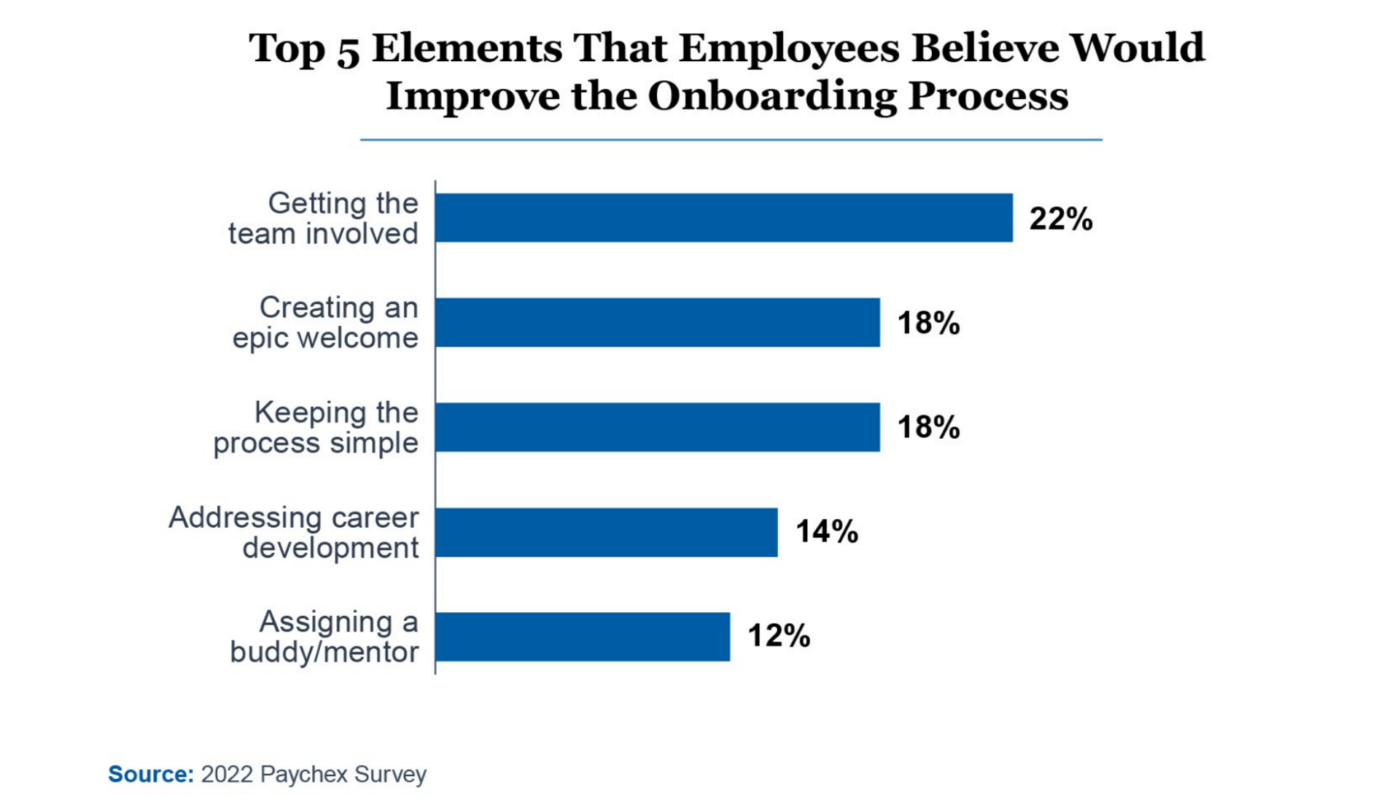
But the catch is the work of setting up an onboarding strategy. Without the right tools, it can become too tedious.
How to Retain Top-Talent Employees: 8 Strategies
Losing good employees hurts organizational performance and directly impacts your bottom line. However, shifting into action mode and taking corrective steps early on can cushion much of the damage. After researching a lot of approaches to understand how to retain top talent employees, we have compiled this list of ideas for you.
Here are a few tried-and-tested strategies to attract and retain top talent.
1. Motivate—and incentivize—employees
Your company’s environment plays a big role in retaining top talent and reducing employee turnover. Your employees should feel that the organization actively supports their aspirations and is taking steps to help them advance in their careers. Rewarding employees for a job well done is the biggest motivator and empowers them to give their best.
Moreover, candidates today want the whole package in a job—personalized benefits, emotional well-being, and a meaningful career. They want professional development opportunities without losing sight of their personal goals.
The best way to motivate and empower teams is by providing them with clear goals, objectives, and resources to help them get there.
ClickUp provides you with a structured way of setting goals, assessing their achievement, and identifying top performers—ClickUp Goals.

With goals clearly identified and linked to their everyday tasks, employees will better understand how they impact the company’s growth and their own.
You don’t need to worry about your team hitting objectives as you get instant visibility into who is working on what.
However, just setting goals isn’t enough. Managers must conceptualize unique ways to incentivize new employees and build meaningful connections within the first year itself.
And you don’t need to drive grand employee reward programs; start small.
For instance, you could:
- Invest in dedicated employee recognition software or employee engagement software to highlight achievements, give shoutouts, etc.
- Think of out-of-the-box employee appreciation gifts for every team member who performs well or showcases company values
- Use ClickUp’s Chat View to give shoutouts to top performers and commend them for their valued contributions:
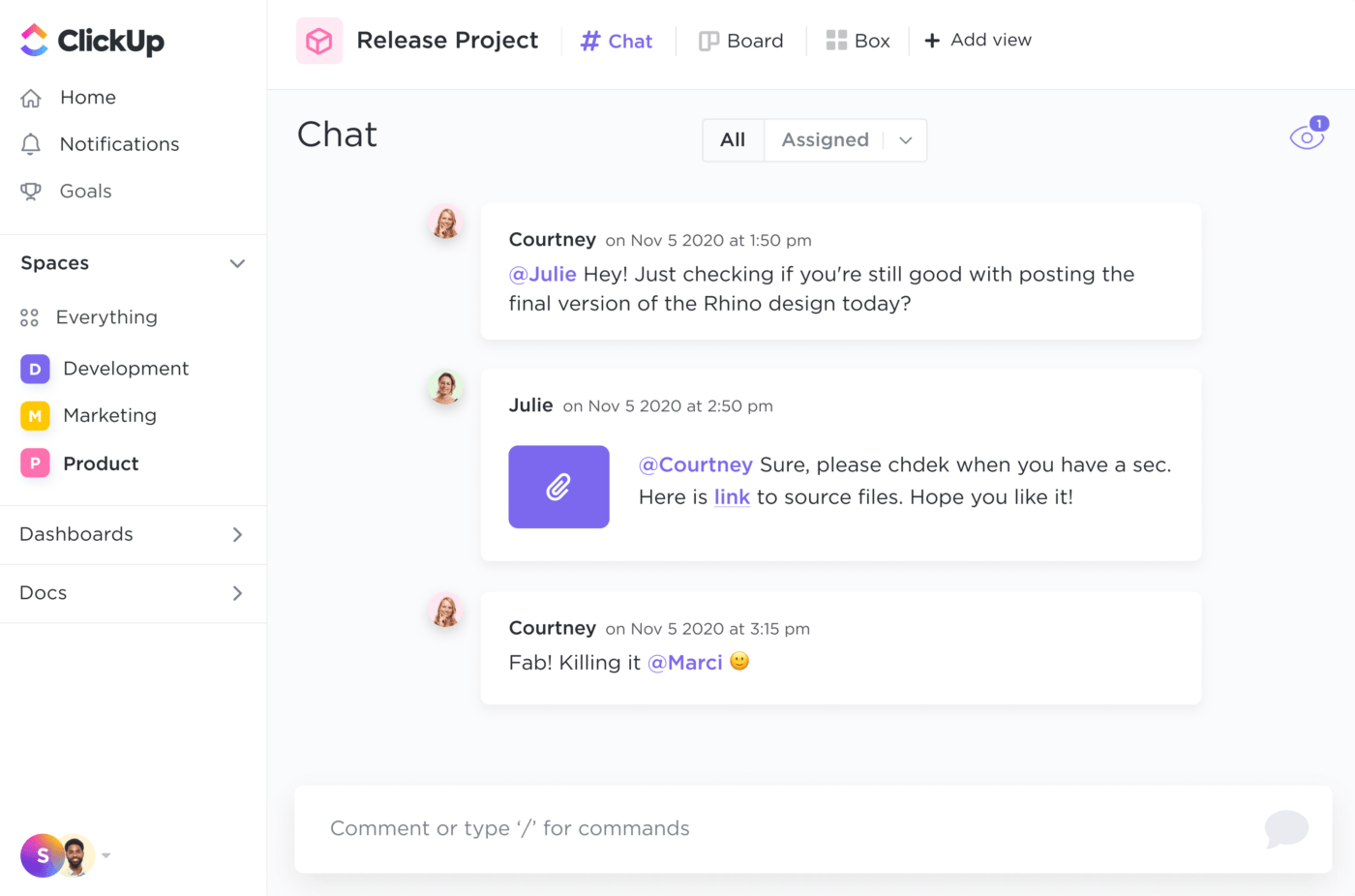
Recognizing—and rewarding—top performers is one of the best ways to retain employees and improve their morale.
2. Drive career development opportunities
Your talented employees must be able to view their jobs from a more purpose-driven lens. Ask these questions:
- Do they feel a sense of connection with the organization?
- What is their job’s purpose?
- What kind of influences are impacting their career decision?
The idea is to enable employees to air their professional and personal concerns and climb the corporate ladder with confidence.
Having a clear path of action for employee advancement and promotion helps tremendously. Leverage performance review templates to assess where your employees are at and create a career development plan from there.
Managers should create a career roadmap with their employees’ input. For this, use ClickUp Whiteboards to brainstorm together and map ideas for career growth.
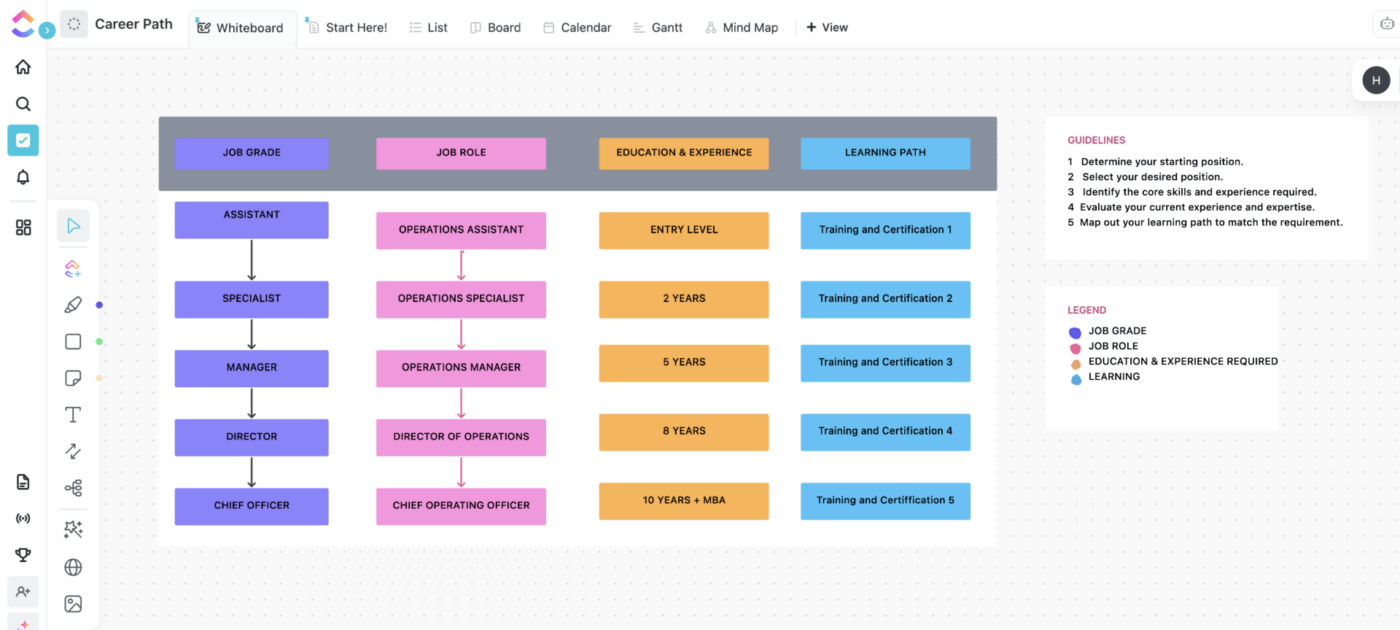
Your retention rates will skyrocket if your employees see the organization investing in advancing their careers.
3. Adopt flexible work options and focus on stress management
Keeping your remote employees productive and engaged is difficult but not impossible with the right strategies up your sleeve:
- Flexible work: Start by offering flexible work options—the number one ask for employees today. Also, don’t micromanage work; instead, promote accountability and trust your team to do their best
- Right compensation packages: The biggest motivator for any employee is fair pay. When researching competitive salaries, include other benefits such as free tuition for the family, childcare services, caregiver support programs, health insurance for parents, etc., and ensure your payscales are within market range
- Stress management: Drive activities and initiatives that allow employees to unwind and promote their well-being; do your research on the best project management tools and pick a platform that best aligns with your employees’ needs. They can then leave the grunt work to the tool and use the time saved to work on passion projects or upskilling
4. Build a positive organizational culture
A positive work environment is critical to retaining top-tier talent. And the beginnings of an employee-centric culture start with:
- An inclusive workplace: Make your employee experience inclusive and welcoming. , They should feel respected and have an increasing sense of belonging with the organization’s values; you should also make them feel that their perspective matters and that the enterprise supports their mental and physical well-being wholeheartedly
- Active listening: In discussions, listen actively to an employee’s viewpoint, repeat what is being said, and use positive body language to demonstrate attentiveness as well as interest
- Strong leadership: Create an empathy-driven leadership style with managers willing to look in the mirror and make changes to the organization as needed. As they say, employees don’t leave companies; they leave bad managers or a toxic work culture
- Supportive culture: Create on-the-job learning opportunities for employees to advance in their career paths and offer support if they seem to be struggling. This could include therapy sessions, one-on-ones with the leadership, an open-door policy, and so on. Also, pick your employees’ minds on:
- Skills they want to develop
- Areas they’re struggling with
- Parts of the job that they find to be most rewarding
- Short- and long-term goals
- Exit interviews: Understand why your employees left and what you could have done better—exit interviews are your gateway into these insights
5. Drive decisions based on talent feedback
Understand how your current talent management initiatives are faring. Interview employees to learn about the root cause of their unhappiness and also what the organization is doing right. Leverage the insights gathered to create a targeted action plan and build a more attractive workplace.
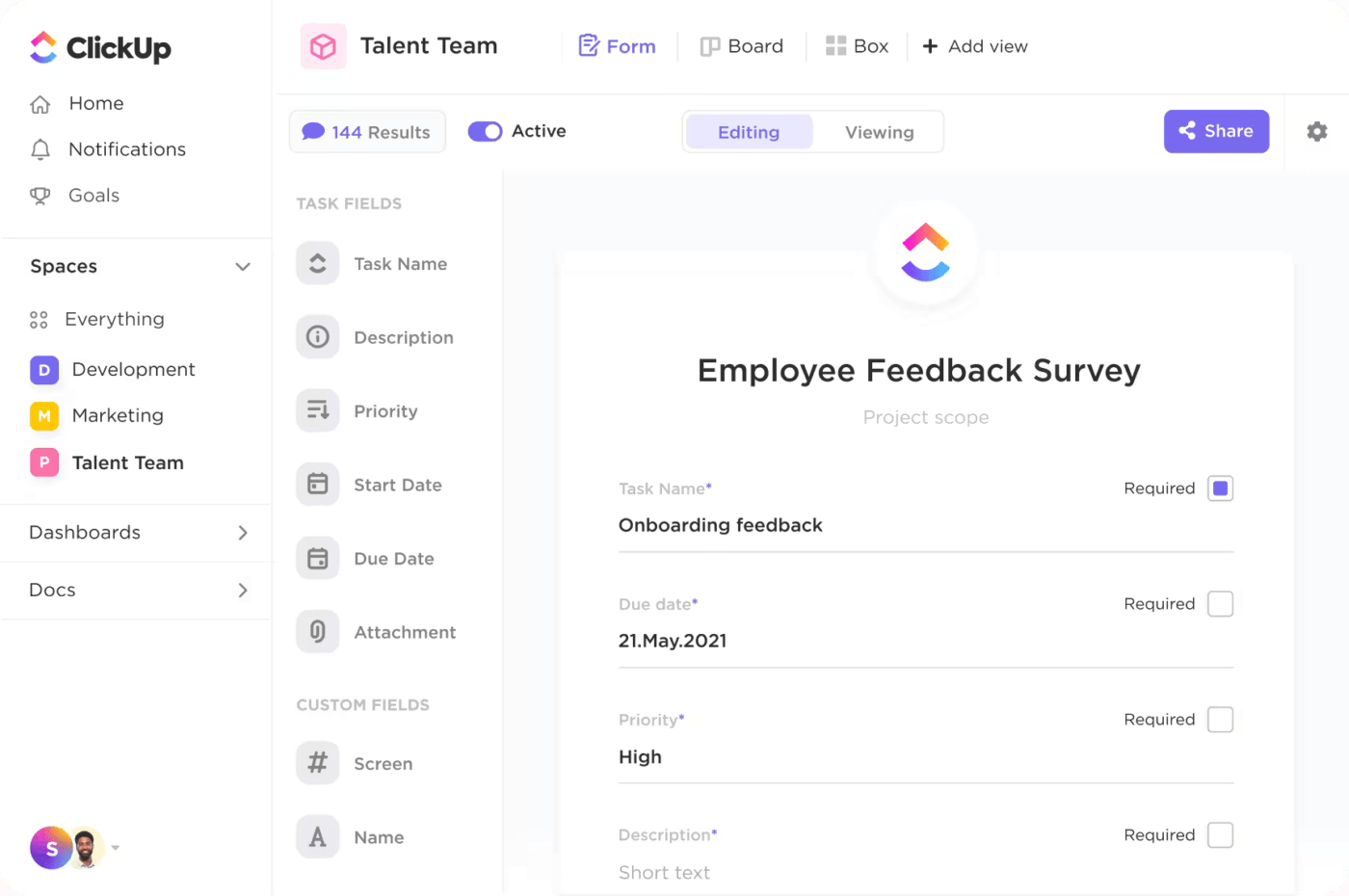
6. Showcase empathy
Offering a competitive salary is a good starting point, but great employers know the value of demonstrating empathy. For them, employee needs are top of mind, and they leave no stone unturned to create an employee-first work culture. This can include offering perks such as flexible hours and paid medical leave and promoting policies around prompt communication, greater autonomy, and more.
7. Don’t turn a blind eye to your turnover rate
While you’re working on retaining top talent, it’s critical to keep an eye out for your attrition rate. Three key factors contribute to a high turnover rate—poor compensation, low focus on people management, and lack of respect. Organizations must focus on employee well-being and build deeper relations to improve the attrition rate. Gartner tells us that an employee-centric value proposition has five elements:
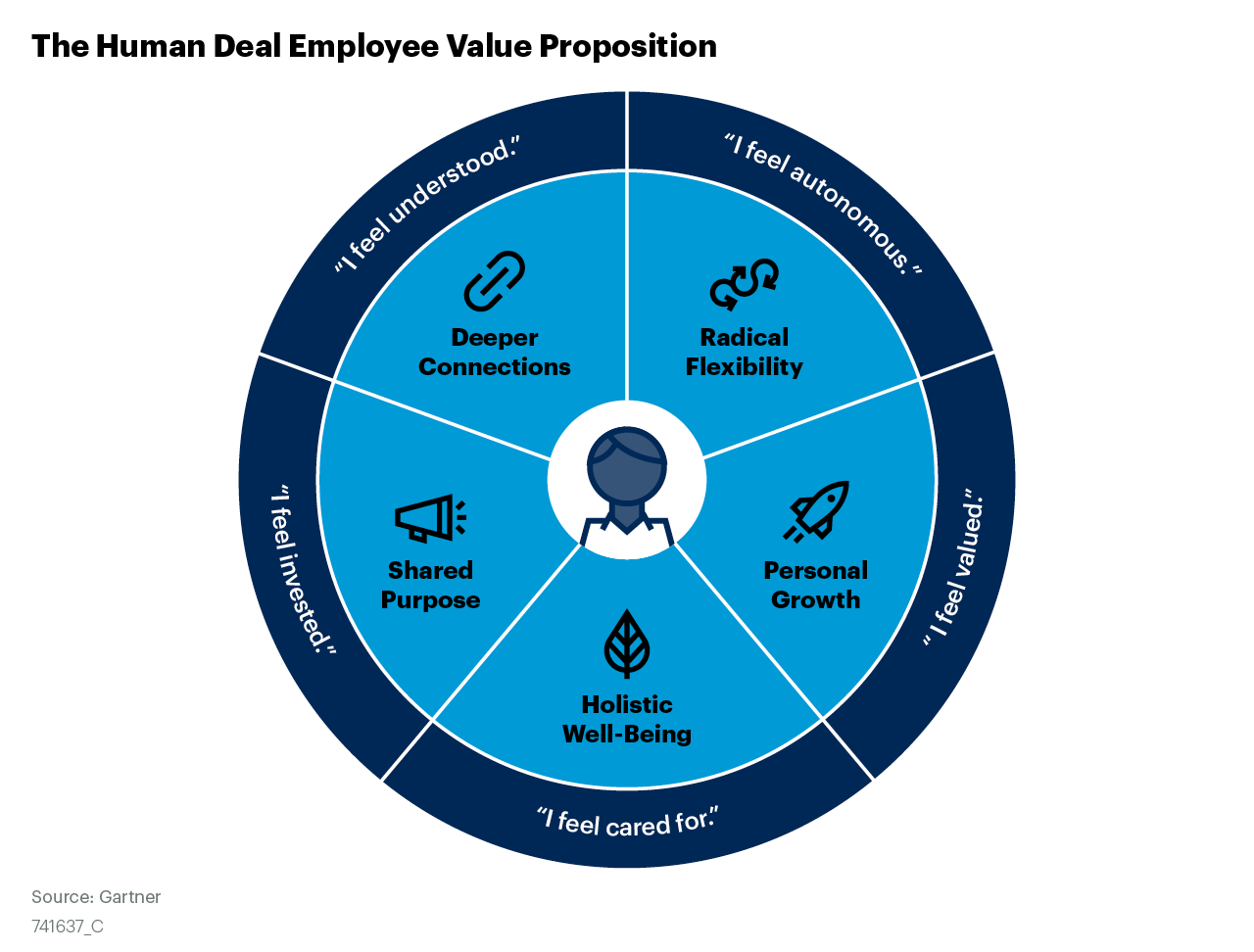
8. Use automation when onboarding employees
Onboarding new hires well is central to boosting the employee experience. Your employees should be primed for what to expect from the company before day one.
This is where ClickUp’s all-in-one HR management platform helps managers save time and enables employees to get a better sense of the organization:

At the recruitment stage, managers can set up an organized system for storing sensitive candidate data, tracking applications, and driving outreach. On the employee side, you must ensure their hiring experience is not effort-intensive.
ClickUp’s HR software streamlines onboarding tasks and helps move candidates through the recruiting pipeline quickly.
A systematic onboarding process automated by ClickUp also allows managers to track employee experience, engagement, performance, and development—all with customizable views at their fingertips. Employees can access a central hub for company-related information, including confidentiality policies and high-level instructions.
That’s not the end of it. A robust HR software offers HR templates that cut out more work for managers and new hires. These preformatted documents set the tone for what the hiring manager expects from the new hire, whereas the latter don’t need to waste time filling out endless administrative documents.
Invest in the first-year experience to make your employees feel valued and heard by the organization—a stepping stone to building long-term loyalty.
Keep High-Quality Talent At the Center of Your Retention Strategy, Always
This guide underscores the importance of knowing how to retain top talent employees. The benefits can be felt across your employee retention strategy and employee happiness index (if your organization has a documented version).
Talented employees who can be their authentic selves are happier, more motivated, and less likely to quit.
On the employer’s side, you get to cement a positive impression within the industry as an employee-centric brand—one that values its employees and does everything in its power to see them succeed.
In addition to establishing a positive culture and a balanced work environment, you must arm your employees with the latest tools to ease their workload and stress—sounds like a job for a multi-purpose tool like ClickUp.
Whether you want to appreciate employees, keep their personal well-being top of mind, or help them plan their career path more confidently, an all-in-one project management tool like ClickUp shines in every area. Sign up and see for yourself!
Frequently Asked Questions (FAQ)
1. How do you attract and retain top talent?
Use these tips to attract and retain top talent within your organization:
- Offer competitive compensation and benefits by regularly reviewing the current industry standards
- Provide additional perks such as health insurance, childcare services, flexible work arrangements, etc.
- Build a positive work culture that prioritizes the employees’ needs as much as it prioritizes the customers
- Drive initiatives to help employees let off steam, such as offering gym memberships, conducting yoga or meditation classes, taking the team to an offsite retreat, and so on
- Prepare personalized training and learning opportunities for employees to help them grow in their career
- Improve the current leadership practices by training managers to communicate with employees honestly, engage in productive conflict resolution, etc.
2. How do you motivate and retain top talent?
Here are a few strategies on how to motivate and retain top talent within your company:
- Offer shoutouts and reward them publicly for a job well done
- Create a formal recognition program to appreciate top employees
- Promote more initiatives that lay the foundation for work-life balance
- Instill a sense of purpose and belonging within the employee
3. What does retaining top talent mean?
Retaining top talent refers to key strategies and practices organizations leverage to keep their most valuable and high-performing employees from leaving.
This involves creating an environment where employees are engaged, satisfied, and motivated to stay with the company for the long term.
The success of any organization depends on knowing how to retain top talent employees, as they bring significant skills, knowledge, and experience to the table. Losing these employees can have a negative impact on recruiting, training, and productivity.



